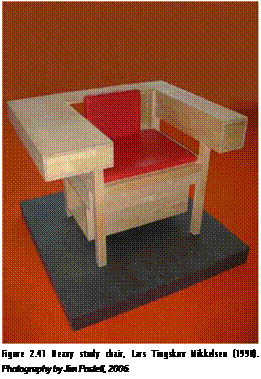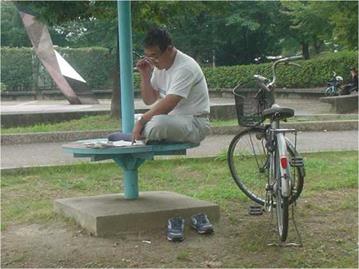Furniture becomes multifunctional the moment we toss clothes on a chair or sit on a table. Tabletops function as places to set items and serve as places to eat, drink, and work. Tables can also accommodate the desire or need to sit and rest (Figure 2.40), just as chairs can incorporate drawers and open shelving for storing and organizing items (Figure 2.41).
Many furnishings are designed to serve more than one purpose, especially in small spaces where efficiency and economy are required. The Valet chair (Figure 2.42) designed

 |
 |
by Hans J. Wegner (1951-1953) is a stool conceived to function as a clothes valet and chair for students living in dormitories at Saint Catherine’s College in Oxford, England. The seat pan is hinge-mounted near the front, which can be lifted to access a small recessed tray that is useful for storing personal items. The chair’s back is profiled to support a shirt or jacket.
Futons
The futon is a traditional Japanese bedding system. It includes the shikibuton (floor mat) on which a person sleeps and the kakebuton (duvet/comforter) that covers the body. Its portability allows it to be stored when not in use. This is an important feature because traditional Japanese living spaces are compact. The futon is placed on tatami mats, which are traditionally 2-inch (5 cm) thick woven reed flooring mats that are 35Уг inches (90 cm) wide by 71 inches (180 cm) long and inset into the floor.6 Futon mattresses are simple cotton mats that are flexible and foldable. Western societies utilize adjustable wooden frames to help place the futon in either a sitting or sleeping position to offer a night of rest.
Storage-Display Units
Retail environments rely on shelving systems to store and display products as well as to organize space. The primary goal of retail display is to promote the sale of merchandise. Consider the baker’s rack, which is typically used in the food preparation industry. A baker’s rack is easy to assemble, offers a flexible arrangement, provides clear lines of sight, and can be configured in multiple shelf heights. It is a transferable shelving system for settings as diverse as warehouses, pharmacies, and personal garages. Verner Panton and Peter J. Lassen collaborated on a similar shelving system made with chromed
metal rods called the Wire Cube in 1970 (Figure 2.43). The Wire Cube is produced for commercial use by Montana and recalls the pragmatic utility and visual language of the traditional baker’s rack.

